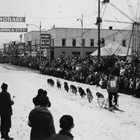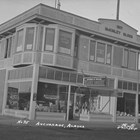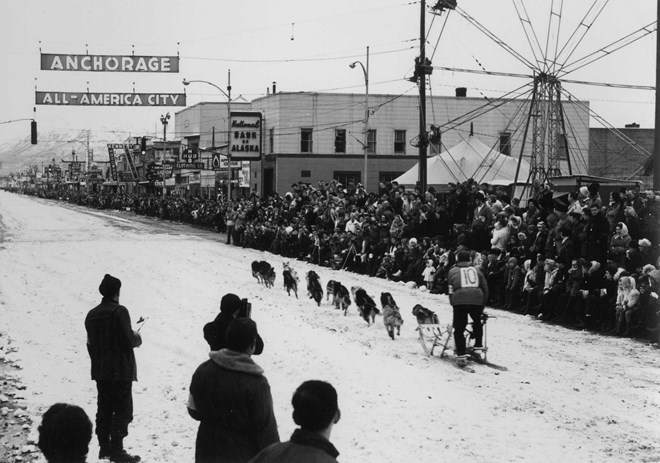Kennedy, George
1888-1966 | Businessman
George Kennedy was an Anchorage merchant who operated Kennedy Hardware on the south side of Fourth Avenue (406 Fourth Avenue) in Anchorage, with his older brother, John Kennedy, from the 1930s to about 1945.
Daniel Kennedy, Sr. and the Kennedy Family
George Kennedy’s father, Daniel Kennedy Sr., was a prospector who had worked his way up the west coast of the United States and Canada, finally moving to Sitka in 1876, after failing to strike it rich in Cassiar, in southern British Columbia, during the Cassiar gold rush (1873-1876). The Kennedys were an early pioneer family from Juneau, having arrived in the town within months of the discovery of placer gold deposits in the area. In 1880, news of the discovery of gold by two prospectors, Richard Harris and Joe Juneau, in the creeks above the Gastineau Channel between the mainland and Douglas Island, north of Stephens Passage, set off a rush of about 2,000 people.1
His Alaskan-born wife, Ekaterina (Katrina or Katherine) Kvasnikoff Kennedy, was the daughter of Feodor Grigorich Kvasnikoff,2who was born near Moscow, Russia. He came to Alaska as a Russian Orthodox clergyman prior to the transfer of Alaska from Russia to the United States. Once in Alaska he married a local woman and moved to the farming community of Ninilchik on the Kenai Peninsula.
George Kennedy
George Kennedy was born in Juneau, Alaska on September 19, 1888, the youngest of five sons born to Irish immigrant Daniel O’Connell Kennedy Sr., and Ekaterina Kvasnikoff Kennedy. He spent his boyhood there except for nearly two years in 1902-1904 when the family moved to the Homer area of the Kenai Peninsula to homestead and prospect for coal. According to the 1900 and 1910 U.S. Censuses, he continued living with his family in Juneau at least through 1910.3
Sometime between 1910 and 1917, Kennedy left Juneau and moved to Cordova, Alaska. From 1915 to 1917, he was the deputy collector of customs and immigration inspector for the U.S. Customs Service in Cordova.4 According to his World War I draft registration card, in July 1917, he worked for the U.S. Customs Service, but also claimed an exemption from military service as a federal employee.5 In 1917-1918, he also worked as the manager of Will Clayson’s Cordova store while retaining his federal job.6 In 1918, he entered the U.S. Army as a private in the 47nd Company, 166th Depot Brigade, stationed at Camp Lewis, Washington.7 The purpose of the Depot Brigades was “to receive and organize recruits, provide them with uniforms, equipment and initial military training, and then send them to France to fight on the front lines. The Depot Brigades also received soldiers returning home at the end of the war and completed their out processing and discharges.”8
By 1923-1924, Kennedy was living in Anchorage, where he was employed as a warehouseman for the Alaska Railroad.9 The 1930 U.S. Census lists Kennedy as being single, living in Anchorage, a merchant with a hardware store, and as a World War I veteran.10 The hardware store is almost certainly Kennedy Hardware, located on the south side of the street at 406 Fourth Avenue. Ten years later, in 1940, Kennedy was still working as a proprietor of an Anchorage hardware store.
By 1940, Kennedy had married Thea Josephine Odegaad, age thirty-three, who worked as a typist at Kennedy Hardware as an unpaid family member.11 The couple lived in the McKinley Apartments on 513 Fourth Avenue, in Anchorage.12
George Kennedy was one of four Kennedy brothers living in Anchorage beginning in the early 1920s. His brothers James Francis Kennedy and Daniel O. Kennedy Jr., were owners of Kennedy Brothers clothing store. The Kennedy Brothers clothing store’s final location was at 434 Fourth Avenue, several doors down from George’s hardware store. George’s eldest brother, John, worked for him at Kennedy Hardware.
George Kennedy remained in Anchorage until 1945.13 He then moved to Seattle, where he and Jack Waterworth (an early Anchorage pilot) had established a hardware store in 1943. Waterworth and Kennedy continued operating their hardware store until its closure in 1951.14
George Kennedy died on November 19, 1966 in Seattle, Washington. He is buried at Evergreen Washilli Memorial Park in Seattle, Washington. Thea Josephine Kennedy died on November 25, 1999.
Endnotes
- Stephen Haycox, Alaska: An American Colony (Seattle: University of Washington Press, 2002), 188; and Claus-M. Naske and Herman E. Slotnick, Alaska: A History, Third Edition (Norman: University of Oklahoma Press, 2011), 113.
- Wayne Leman, editor, Agrafena's Children: The Old Families of Ninilchik, Alaska (Agrafena Press, 1993), 289-290.
- George Kennedy, 1900 U.S. Census, Juneau, Southern Supervisor’s District, Alaska, 1900 United States Federal Census [database on-line], http://ancestry.com (accessed August 22, 2014); and George Kennedy, 1910 United States Federal Census, Juneau, Division 1, Alaska Territory, 1910 United States Federal Census [database on-line], http://ancestry.com (accessed August 22, 2014).
- George Kennedy, U.S., Register of Civil, Military, and Naval Service, 1863-1959 [database on-line], http://ancestry.com (accessed January 5, 2015).
- Draft registration card, George Kennedy, July 6, 1917, Cordova, Third Judicial District, Alaska, National Archives Microfilm Publication M1509, World War I Selective Service System Draft Registration Cards, 1917-1918, Roll AK1, U.S., World War I Draft Registration Cards, 1917-1918 [database on-line], http://ancestry.com (accessed January 2, 2015).
- George Kennedy, R.L. Polk and Company, Alaska Gazetteer and Business Directory, 1917-1918 (Seattle, WA: R.L. Polk, Inc., 1918), 198.
- George Kennedy, U.S., Find a Grave Index, 1600s-Current [database on-line], http://ancestry.com (accessed August 22, 2014).
- “152nd Depot Brigade,” in Wikipedia, http:// http://en.wikipedia.org/wiki/152nd_Depot_Brigade (accessed January 4, 2015).
- George Kennedy, R.L. Polk’s Alaska-Yukon Gazetteer, 1923-1924 (Seattle, WA: R.L. Polk & Company, 1924), 198.
- George Kennedy, U.S. 1930 Census, Anchorage, Third Judicial District, Alaska Territory, ED 3-14, stamped page 187, National Archives Microfilm Publication T626, Fifteenth Census of the United States, 1930, Roll 2627, 1930 United States Federal Census [database on-line], http://ancestry.com (accessed August 22, 2014).
- George Kennedy, 1940 U.S. Census, Anchorage, Third Judicial Division, Alaska, ED 3-22, stamped page 112, National Archives Microfilm Publication T627, Sixteenth Census of the United States, 1940, Roll 4580, 1940 United States Federal Census [database on-line], http://ancestry.com (accessed August 22, 2014).
- Entry for George Kennedy, Telephone Directory, City of Anchorage, Alaska (Anchorage: Telephone Department, May 1945), 29; and Thea Josephine Kennedy, U.S., Social Security Applications and Claims Index, 1936-2007 [database on-line], http://ancestry.com (accessed August 4, 2016).
- Entry for George Kennedy, Telephone Directory, City of Anchorage, Alaska (Anchorage: Telephone Department, May 1945), 29.
- John P. Bagoy, Legends & Legacies, Anchorage, 1910-1935 (Anchorage: Publications Consultants, 2003), 345-346.
Sources
A biographical essay for George Kennedy was not included in John Bagoy’s Legends & Legacies, Anchorage, 1910-1935 (Anchorage: Publications Consultants, 2003). See also the Dan Kennedy file, Bagoy Family Pioneer Files (2004.11), Atwood Resource Center, Anchorage Museum at Rasmuson Center, Anchorage, AK. By Walter Van Horn, January 4, 2015. Note: edited slightly by Bruce Parham, August 4, 2016.
Preferred citation: Walter Van Horn and Bruce Parham, “Kennedy, George,” Cook Inlet Historical Society, Legends & Legacies, Anchorage, 1910-1940, http://www.alaskahistory.org.
Major support for Legends & Legacies, Anchorage, 1910-1940, provided by: Anchorage Museum at Rasmuson Center, Atwood Foundation, Cook Inlet Historical Society, and the Rasmuson Foundation. This educational resource is provided by the Cook Inlet Historical Society, a 501 (c) (3) tax-exempt association. Contact us at the Cook Inlet Historical Society, by mail at Cook Inlet Historical Society, Anchorage Museum at Rasmuson Center, 625 C Street, Anchorage, AK 99501 or through the Cook Inlet Historical Society website, www.cookinlethistory.org.



